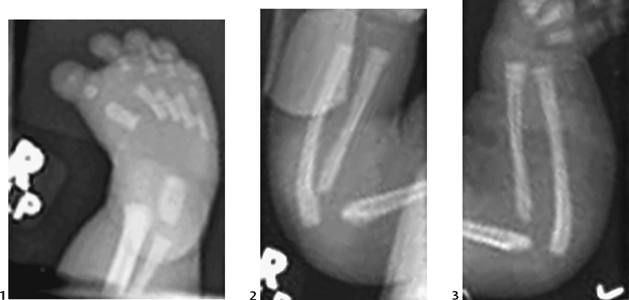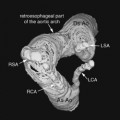CASE 123 A newborn infant presents with multiple dislocations of small and large joints, mild bowing of femora, bilateral clubfeet, and respiratory distress. Figure 123A Figure 123B Cervical platyspondyly with reversed lordosis and marked pedicular hypoplasia is present (Fig. 123A1). Moderate shortening of second through fifth metacarpals with severe shortening of first metacarpal (Fig. 123A2) and bilateral clubfeet (Fig. 123B1) with severe metatarsus adductus are observed. The elbow radiographs (Figs. 123B2 and 123B3) show bilateral radial head dislocation. The midthoracic vertebral column (Fig. 123B4) shows congenital dextroscoliosis. Severe hypoplasia of the distal scapulae with preservation of the glenoids is present. Mild lateral bowing of midfemoral diaphyses (Fig. 123B5) is noted. Congenital dislocation of left femoral head (Fig. 123B5) and hypoplasia of distal fibulae with vertical orientation of calcanei are also noted (Fig. 123B6). Campomelic dysplasia (campomelic syndrome) Campomelia means “bent bones,” and campomelic dysplasia is a severe multisystem syndrome/dysplasia, usually manifesting bent (but not shortened) long bones. It is often fatal in the neonatal period. Long-term survivors usually demonstrate severe orthopedic, neurologic, and respiratory difficulties. The reported incidence is 0.5 per 100,000 live births. Campomelic dysplasia is an autosomal dominant defect in the SOX-9 gene, located on chromosome 17. This defect results in haploinsufficiency of SOX-9
Clinical Presentation



Radiologic Findings
Diagnosis
Differential Diagnosis
Discussion
Background
Etiology
![]()
Stay updated, free articles. Join our Telegram channel

Full access? Get Clinical Tree








